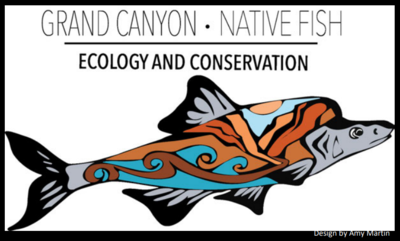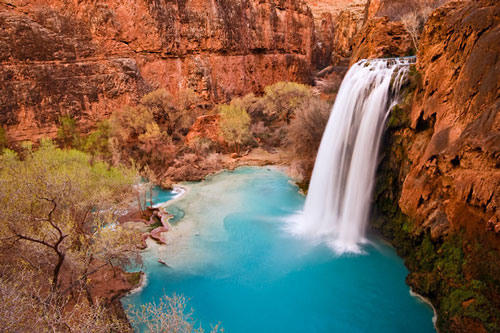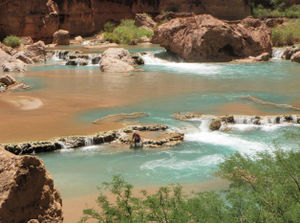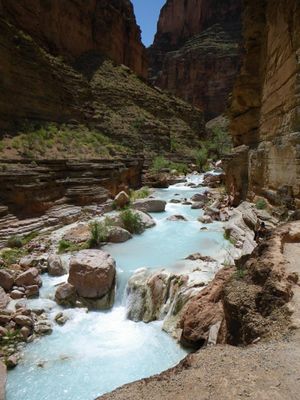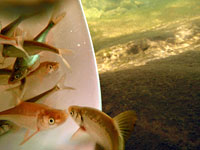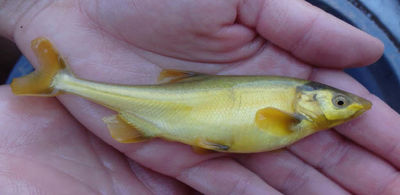Difference between revisions of "Translocation Projects"
Cellsworth (Talk | contribs) |
Cellsworth (Talk | contribs) |
||
| (42 intermediate revisions by the same user not shown) | |||
| Line 17: | Line 17: | ||
</table> | </table> | ||
| + | [[Image:HumpbackChubAmyMartin.PNG|thumb|center|400px| ]] | ||
| + | [[Image:Havasu-Falls-in-Grand-Canyon-41.jpg|thumb|center|500px|Havasu Falls]] | ||
<!-- | <!-- | ||
| Line 23: | Line 25: | ||
|style="width:60%; font-size:120%;"| | |style="width:60%; font-size:120%;"| | ||
| + | == [http://gcdamp.com/index.php?title=Long-term_Experimental_and_Management_Plan_(LTEMP) LTEMP BiOp Conservation Measures for Humpback Chub Conservation (2016)] == | ||
| + | |||
| + | Reclamation would continue to support the NPS, FWS, GCMRC, and GCDAMP in | ||
| + | funding and implementing '''translocations''' of humpback chub into tributaries of the | ||
| + | Colorado River in Marble and Grand Canyons, and in monitoring the results of these | ||
| + | translocations, consistent with agencies’ plans and guidance (e.g., NPS Comprehensive | ||
| + | Fisheries Management Plan [CFMP], FWS Humpback Chub Genetics Management Plan | ||
| + | and Translocation Framework, and GCMRC Triennial Work Plan). Translocations allow | ||
| + | for opportunities to expand the area occupied by humpback chub and improve the overall | ||
| + | status of the species. Specifically, the following would occur: | ||
| + | |||
| + | *Humpback chub would be translocated from the lower reaches of the Little Colorado River to areas above Chute Falls in an effort to increase growth rates and survivorship. | ||
| + | |||
| + | *Monitoring would be conducted annually, or as needed, depending on the data required, to determine survivability, population status, or genetic integrity of the Havasu Creek humpback chub population. Intermittent translocations of additional humpback chub in Havasu Creek would be conducted if the FWS and NPS determine it is necessary to maintain genetic integrity of the population. | ||
| Line 37: | Line 53: | ||
|class="MainPageBG" style="width:55%; border:1px solid #cef2e0; background:#f5faff; vertical-align:top; color:#000;"| | |class="MainPageBG" style="width:55%; border:1px solid #cef2e0; background:#f5faff; vertical-align:top; color:#000;"| | ||
{|width="100%" cellpadding="2" cellspacing="5" style="vertical-align:top; background:#f5faff;" | {|width="100%" cellpadding="2" cellspacing="5" style="vertical-align:top; background:#f5faff;" | ||
| − | ! <h2 style="margin:0; background:#cedff2; font-size:120%; font-weight:bold; border:1px solid #a3bfb1; text-align:left; color:#000; padding:0.2em 0.4em;"> | + | ! <h2 style="margin:0; background:#cedff2; font-size:120%; font-weight:bold; border:1px solid #a3bfb1; text-align:left; color:#000; padding:0.2em 0.4em;">Projects</h2> |
| + | |- | ||
| + | |style="color:#000;"| | ||
| + | |||
| + | =='''Chute Falls Translocation (Little Colorado River)'''== | ||
| + | [[Image:ChuteFalls.jpg|thumb|right|300px|Chute Falls]] | ||
| + | [https://www.youtube.com/watch?v=TmsreYCOhnc| YouTube: Humpback Chub Translocation in the Little Colorado River ] | ||
| + | |||
| + | ===Background [https://www.usbr.gov/uc/rm/amp/twg/mtgs/13jan24/11_Young.pdf]=== | ||
| + | *Prior to translocations: no HBC above Chute Falls (fish barrier or high CO2 levels). Since 2003, six chub have been documented ascending Chute Falls on their own accord. [https://www.usbr.gov/uc/rm/amp/twg/mtgs/15jan20/Attach_07.pdf] | ||
| + | *High productivity and higher winter water temperatures than the lower LCR should equal higher growth rates and faster maturity | ||
| + | *Translocations began 2003 | ||
| + | *~3,106 juvenile humpback chub have been translocated from the lower reaches of the LCR to upstream of Chute Falls (2015) [https://www.usbr.gov/uc/rm/amp/twg/mtgs/15jan20/Attach_07.pdf] | ||
| + | *Annual Monitoring – hoop nets surveys in May or June | ||
| + | |||
| + | ===Objectives=== | ||
| + | '''2003-2005 [https://www.usbr.gov/uc/rm/amp/twg/mtgs/13jan24/11_Young.pdf]''' | ||
| + | *Determine if HBC can survive and remain above Chute Falls: yes, translocated fish had higher survival than Coggins et al. 2006 estimate. Good retention during most years but populations is susceptible to stochastic events (e.g. 2010 flood) | ||
| + | *Determine if HBC grow (given increased food availability, but potential detrimental impacts from CO2): | ||
| + | #By the 1st ensuing spring since being released 16% of age-1 translocated chub had achieved adult size (>200 mm TL). | ||
| + | #By the 2nd ensuing spring since being released 96% of age-2 chub had achieved adult size. [https://www.usbr.gov/uc/rm/amp/twg/mtgs/15jan20/Attach_07.pdf] | ||
| + | *Determine if HBC can recruit to adulthood: yes | ||
| + | *Determine if HBC spawning population will develop: tbd | ||
| + | '''2006-Present [https://www.usbr.gov/uc/rm/amp/twg/mtgs/13jan24/11_Young.pdf]''' | ||
| + | *Conduct mark/recapture population estimates – 2 reaches (>CF and LA to CF) to determine: | ||
| + | #Migration patterns: Chute is not a complete barrier to chub moving upstream, movement throughout, including to the mainstem | ||
| + | #Growth rates: higher growth rates than fish lower in the LCR | ||
| + | #Spawning activity: ripe fish and YOY fish found above Chute in 2007 | ||
| + | #Assess overall benefit to LCR HBC: Appears to be one of few tools available to directly increase adult population if needed in future. | ||
| + | |||
| + | Translocations are relatively easy and inexpensive beneficial conservation actions compared to other options that may be much more expensive and politically difficult to implement. [https://www.usbr.gov/uc/rm/amp/twg/mtgs/17jan26/AR13_VanHaverbeke.pdf] | ||
| + | |||
| + | =='''Havasu Creek Translocations'''== | ||
| + | Included as a Conservation measure in the 2008 and 2011 Biological Opinions <br> | ||
| + | |||
| + | [[File:Havasu Creek lower barrier near confluence 2-Sorensen-2011.JPG|thumb|right|300px|Falls in Lower Havasu Creek]] | ||
| + | |||
| + | ===Background === | ||
| + | Monitor translocated Humpback Chub and fish community in creeks and nearby Colorado River mainstem | ||
| + | *Survey twice annually | ||
| + | *Survey the mainstem Colorado River annually- GCMRC/FWS & NPS | ||
| + | *Remove non-native fish captured during surveys | ||
| + | |||
| + | ===Objectives === | ||
| + | *Establishment of a second spawning and recruiting population in the mainstem or tributary | ||
| + | *Sufficient survival and growth to provide a rearing (“grow-out”) opportunity to augment the local mainstem aggregation | ||
| + | *Maintain at least 20% of HBC to survive in the creek or adjacent mainstem aggregation for at least one year [https://www.usbr.gov/uc/rm/amp/twg/mtgs/16jan26/documents/AR18_Omana%20Smith.pdf] | ||
| + | |||
| + | ===Metrics=== | ||
| + | *Retention of translocated humpback chub over the first year | ||
| + | *Similar or increased juvenile survival relative to the Little Colorado River and mainstem Colorado River near the Little Colorado River inflow | ||
| + | *Similar or increased growth rates relative to the Little Colorado River and mainstem Colorado River near the Little Colorado River inflow | ||
| + | *Contribution to and retention of translocated fish to an adjacent mainstem aggregation | ||
| + | *Evidence of successful reproduction (presence of larval or young-of-year fish) | ||
| + | *Evidence of recruitment to mature size [https://www.usbr.gov/uc/rm/amp/twg/mtgs/16jan26/documents/AR18_Omana%20Smith.pdf] | ||
| + | |||
| + | ===Project History=== | ||
| + | Translocated 1650 humpback chub (total): | ||
| + | *2011: 243 | ||
| + | *2012: 298 | ||
| + | *2013: 300 | ||
| + | *2014: 509 | ||
| + | *2015: 300 [https://drive.google.com/file/d/0BwY-Z2c3NTUGdXc2WHJOWkdBX3M/view] | ||
| + | |||
| + | ===Results=== | ||
| + | *Similar survival relative to Little Colorado River and nearby mainstem (which is higher, Yackulic et al. 2014) | ||
| + | *Growth rates as high or higher than the LCR | ||
| + | *Evidence of natural reproduction and recruitment since 2013 | ||
| + | |||
| + | ===Next Steps=== | ||
| + | Triggers for additional HBC translocations to maintain genetic diversity (see FWS 2010) | ||
| + | *Minimum of 200 adults maintained | ||
| + | *At least 10 migrants/ generation (or add additional 10) | ||
| + | *45-1000 released over a generation (10 years) [https://www.usbr.gov/uc/rm/amp/twg/mtgs/16jan26/documents/AR18_Omana%20Smith.pdf] | ||
| + | |||
| + | =='''Shinumo Creek Translocations '''[https://www.usbr.gov/uc/rm/amp/twg/mtgs/14oct28/Attach_11.pdf]== | ||
| + | Included as a Conservation measure in the 2008 and 2011 Biological Opinions <br> | ||
| + | |||
| + | ===Background === | ||
| + | [[Image:ShinumoWaterfall.jpg|thumb|right|300px|Falls at the mouth of Shinumo Creek]] | ||
| + | [[Image:AntennaInstal10.jpg|thumb|right|300px|PIT antenna install in Shinumo Creek]] | ||
| + | [[Image:chub bucket NPS.jpg|right|300px]] | ||
| + | [https://www.nps.gov/grca/learn/nature/shinumotransloc.htm Grand Canyon National Park translocations] [https://www.nps.gov/grca/learn/nature/fish-humpback-chub.htm (more information)] | ||
| + | |||
| + | ===Objectives === | ||
| + | *Primary: Develop second spawning population | ||
| + | *Provide rearing (grow-out) opportunities, augmentation of mainstem aggregations | ||
| + | |||
| + | ===Project History=== | ||
| + | Translocated 1,102 humpback chub (total): | ||
| + | *2009: 302 | ||
| + | *2010: 300 | ||
| + | *2011: 300 | ||
| + | *2013: 200 | ||
| + | June 2014 population estimate: ≈125 to 190 individuals (preliminary; all years represented)<br> | ||
| + | Three HBC translocated to Shinumo Creek have been detected at the antenna array in the LCR [https://drive.google.com/file/d/0BwY-Z2c3NTUGdXc2WHJOWkdBX3M/view] | ||
| + | |||
| + | ===Results=== | ||
| + | *Meeting Objectives for rearing/”grow-out” | ||
| + | *Annual growth greater than in the mainstem Colorado River but less than in the LCR 2 out of 3 years (2013-14 results pending) | ||
| + | *Large portion of mainstem captures at the mouth of Shinumo are translocated fish | ||
| + | *No reproduction (but fish were still young) | ||
| + | |||
| + | ===Galahad Point Fire – May-July 2014 [https://www.usbr.gov/uc/rm/amp/twg/mtgs/14oct28/Attach_11.pdf]=== | ||
| + | Shinumo Creek flooding (containing ash) reported in July and August | ||
| + | *PIT tag antenna destroyed in July | ||
| + | *>99% decline in fish, overall | ||
| + | *High density of rainbow trout in Merlin Abyss Creek (½ mile of undamaged habitat) | ||
| + | *Bluehead sucker and humpback chub believed to be extirpated | ||
| + | *Significant channel alteration, pools filled | ||
| + | *80-90% loss of riparian vegetation | ||
| + | |||
| + | ===Next Steps=== | ||
| + | *Remove remaining trout in Merlin Abyss | ||
| + | *Monitor habitat recovery | ||
| + | *In 3-5 years restore native fish community throughout watershed (humpback chub, speckled dace, bluehead sucker) | ||
| + | |||
| + | ==Bright Angel Creek Translocations== | ||
| + | *[https://www.usbr.gov/uc/rm/amp/amwg/mtgs/18may22/AIF_BA.pdf Translocation of Humpback Chub into Bright Angel Creek: A Joint Project of Grand Canyon National Park, Bureau of Reclamation, and U.S. Fish and Wildlife Service] | ||
| + | *[https://www.researchgate.net/publication/324823294_Review_of_Effective_Suppression_of_Nonnative_Fishes_in_Bright_Angel_Creek_2012-2017_with_Recommendations_for_Humpback_Chub_Translocations Review of Effective Suppression of Nonnative Fishes in Bright Angel Creek, 2012-2017, with Recommendations for Humpback Chub Translocations] | ||
| + | |||
| + | ===Background === | ||
| + | *[https://www.nps.gov/grca/learn/nature/trout-reduction.htm NPS trout reduction] (2012-2017) | ||
| + | |||
| + | ===Objectives === | ||
| + | |||
| + | ===Project History=== | ||
| + | *Translocation (May 2018) | ||
| + | |||
| + | ===Results=== | ||
| + | |||
| + | ===Next Steps=== | ||
| + | *Implementation of an experimental translocation of Humpback Chub with associated monitoring – monitoring will include 2 netting excursions in spring and fall, similar to other NPS-led translocation projects (see Trammell et al. 2012); | ||
| + | *Installation of a PIT tag antenna array at the mouth of Bright Angel Creek to monitor outmigration of translocated Humpback Chub as well as to assist in the assessment of the impacts of monitoring and handling stress on movements of native fishes; | ||
| + | *Implementation of reduced nonnative mechanical removal, including the targeting of areas with high densities of Brown Trout – in 2018, an electrofishing pass may be conducted throughout the stream followed by additional passes in areas with high densities of trout; | ||
| + | *Continued monitoring of the impacts of electrofishing on native fish vital rates (survival, recruitment, etc.) – PIT tagging may be expanded to smaller size classes, as appropriate and in consideration of the health of the fish; and | ||
| + | *Continued consultation with Tribes, consistent with our MOA under Section 106 of the NHPA. | ||
| + | |||
| + | ==Beaver Falls Translocations (Havasu Creek) (proposed; 2016 Conservation Measure)== | ||
| + | |||
| + | ==Mainstem Translocations in Western Grand Canyon (proposed)== | ||
| + | ==Mainstem Translocations at the LCR (proposed; 2016 Conservation Measure)== | ||
|} | |} | ||
| Line 52: | Line 209: | ||
|style="color:#000;"| | |style="color:#000;"| | ||
| − | [http://gcdamp.com/index.php?title= | + | *[[Media:2012 HBC Havasu translocation plan.pdf| Implementation and Monitoring Plan for Humpback Chub Translocation to Havasu Creek, Grand Canyon National Park ]] |
| + | *[http://gcdamp.com/index.php?title=2013_National_Park_Service_Comprehensive_Fisheries_Management_Plan 2013 National Park Service Comprehensive Fisheries Management Plan] | ||
| + | *[https://www.researchgate.net/publication/324823294_Review_of_Effective_Suppression_of_Nonnative_Fishes_in_Bright_Angel_Creek_2012-2017_with_Recommendations_for_Humpback_Chub_Translocations Review of Effective Suppression of Nonnative Fishes in Bright Angel Creek, 2012-2017, with Recommendations for Humpback Chub Translocations] | ||
|- | |- | ||
| − | ! <h2 style="margin:0; background:#cedff2; font-size:120%; font-weight:bold; border:1px solid #a3b0bf; text-align:left; color:#000; padding:0.2em 0.4em;"> | + | ! <h2 style="margin:0; background:#cedff2; font-size:120%; font-weight:bold; border:1px solid #a3b0bf; text-align:left; color:#000; padding:0.2em 0.4em;">Presentations and Papers</h2> |
|- | |- | ||
|style="color:#000;"| | |style="color:#000;"| | ||
| − | * | + | '''2022''' |
| − | + | *[https://www.usbr.gov/uc/progact/amp/twg/2022-01-13-twg-meeting/20220113-AnnualReportingMeeting-HumpbackChubTributaryTranslocationMonitoring-508-UCRO.pdf Humpback Chub Tributary Translocation Monitoring] | |
| − | + | ||
| − | + | ||
| − | + | ||
| − | + | ||
| − | + | ||
| − | + | '''2021''' | |
| − | + | *[https://doi.org/10.1111/1365-2664.13908 Yackulic et al. 2021. Assessing the population impacts and cost-effectiveness of a conservation translocation: Journal of Applied Ecology] | |
| − | | | + | *[https://www.usbr.gov/uc/progact/amp/twg/2021-01-22-twg-meeting/20210122-AnnualReportingMeeting-DriversDemographicRatesTranslocatedHumpbackChubPopulationsAnnualUpdate-508-UCRO.pdf Drivers of Demographic Rates in Translocated Humpback Chub Populations and an Annual Update ] |
| − | + | ||
| + | '''2020''' | ||
| + | *[[Media:2020 NPS 2020 Chub Translocation Activities Final Report final.pdf| NPS 2020 Chub Translocation Activities Final Report ]] | ||
| + | *[https://gcc02.safelinks.protection.outlook.com/?url=https%3A%2F%2Fdoi.org%2F10.1002%2Fnafm.10425&data=02%7C01%7C%7Cbbeb7e87c1ae4f3e60ac08d7dd777fc7%7C31ae220fb94f463a9cfd15bbc9909df5%7C0%7C0%7C637221377637163405&sdata=4fZ77zeyhiTJH3zHHnvNPpPR3r0Hr6%2Fawwgi5X17B1Q%3D&reserved=0 Stone et al. 2020. Effects of disparate water temperatures and food bases on Humpback Chub growth rates within the Little Colorado River, Arizona. North American Journal of Fisheries Management] | ||
| + | |||
| + | '''2019''' | ||
| + | *[https://afspubs.onlinelibrary.wiley.com/doi/epdf/10.1002/nafm.10408 Healy et al. 2019. Establishment of a reproducing population of endangered Humpback Chub Gila cypha through translocations to a Colorado River tributary in Grand Canyon, Arizona. AFS] | ||
| + | *[[Media:NPS trip report Shinumo September2019 24Sept2019 (1).pdf| Shinumo Creek, Shinumo inflow, and invasive species surveillance monitoring, September 3 – 12, 2019 Trip Report]] | ||
| + | *[[Media:NPS 2018 BrightAngel translocation TripReport May2019.pdf| NPS fisheries trip report - Bright Angel Creek 2018 translocation]] | ||
| + | *[https://www.usbr.gov/uc/progact/amp/twg/2019-03-14-twg-meeting/20190314-EfficacyHumpbackChubTranslocationsInvasiveTroutControlGrandCanyonTributaries2012-2018-Presentation-508-UCRO.pdf Efficacy of Humpback Chub translocations and invasive Trout control in Grand Canyon tributaries, 2012-2018] | ||
| + | |||
| + | '''2018''' | ||
| + | *[https://www.usbr.gov/uc/rm/amp/amwg/mtgs/18may22/Attach_05.pdf AIF: Translocation of Humpback Chub into Bright Angel Creek: A Joint Project of Grand Canyon National Park, Bureau of Reclamation and U.S. Fish and Wildlife Service PPT] | ||
| + | *[https://www.usbr.gov/uc/rm/amp/twg/mtgs/18apr23/Attach_08.pdf Bright Angel Brown Trout Removal and Humpback Chub Translocations] | ||
'''2017''' | '''2017''' | ||
| − | *[[Media:VanHaverbeke et al 2017 USFWS Mark recapture and fish monitoring activies in the LCR 2000-2016.pdf| Mark-Recapture and Fish Monitoring Activities in the Little Colorado River in Grand Canyon from 2000 to 2016 (Chute Falls translocation ]] | + | *[[Media:VanHaverbeke et al 2017 USFWS Mark recapture and fish monitoring activies in the LCR 2000-2016.pdf| Mark-Recapture and Fish Monitoring Activities in the Little Colorado River in Grand Canyon from 2000 to 2016 (Chute Falls translocation) ]] |
*[https://www.usbr.gov/uc/rm/amp/twg/mtgs/17jan26/AR13_VanHaverbeke.pdf Humpback Chub in the Little Colorado River and Translocations ] | *[https://www.usbr.gov/uc/rm/amp/twg/mtgs/17jan26/AR13_VanHaverbeke.pdf Humpback Chub in the Little Colorado River and Translocations ] | ||
| Line 93: | Line 260: | ||
*[https://www.usbr.gov/uc/rm/amp/twg/mtgs/13jan24/11_Young.pdf Chute Falls Humpback Chub Translocations Objectives, Effectiveness and Future Work] | *[https://www.usbr.gov/uc/rm/amp/twg/mtgs/13jan24/11_Young.pdf Chute Falls Humpback Chub Translocations Objectives, Effectiveness and Future Work] | ||
*[https://www.usbr.gov/uc/rm/amp/twg/mtgs/13jan24/12_Healy.pdf NPS Fisheries Program Updates: Humpback Chub Translocations] | *[https://www.usbr.gov/uc/rm/amp/twg/mtgs/13jan24/12_Healy.pdf NPS Fisheries Program Updates: Humpback Chub Translocations] | ||
| + | |||
| + | '''2012''' | ||
| + | *[https://www.gcmrc.gov/about/ka/KA%202%20-%201-31-12/AM%20Talks/Healy%200945-1020%202011%20Annual%20Resport%20on%20GRCA_fisheries.pdf 2011 Annual Resport on GRCA_fisheries ] | ||
| + | *[https://www.gcmrc.gov/about/ka/KA%202%20-%201-31-12/AM%20Talks/Paukert%200945-1020%202011%20Annual%20Report%20on%20Translocation%20of%20humpback%20cbub.pdf 2011 Annual Report on Translocation of humpback chub ] | ||
'''2006''' | '''2006''' | ||
| Line 103: | Line 274: | ||
|style="color:#000;"| | |style="color:#000;"| | ||
| + | ==At what flow does the Shinumo Falls reconnect?== | ||
| + | The Shinumo Creek barrier falls begins to be connected to the mainstream at a flow of about 60,000 cfs, based on observations there in 1983. That flow does not overtop the barrier, but opens a jump-up passage. It takes about 100,000 cfs to overtop the whole falls. --Larry Stevens | ||
| + | [[Image:GoldenChub.jpg|thumb|left|400px|The Golden Chub: the finder of this fish gets a prize]] <br> | ||
|} | |} | ||
Latest revision as of 13:47, 15 April 2022
|
|
LTEMP BiOp Conservation Measures for Humpback Chub Conservation (2016)Reclamation would continue to support the NPS, FWS, GCMRC, and GCDAMP in funding and implementing translocations of humpback chub into tributaries of the Colorado River in Marble and Grand Canyons, and in monitoring the results of these translocations, consistent with agencies’ plans and guidance (e.g., NPS Comprehensive Fisheries Management Plan [CFMP], FWS Humpback Chub Genetics Management Plan and Translocation Framework, and GCMRC Triennial Work Plan). Translocations allow for opportunities to expand the area occupied by humpback chub and improve the overall status of the species. Specifically, the following would occur:
|
| -- |
-- |
-- |
|---|
|
|
